Content for TS 38.413 Word version: 18.2.0
1…
4…
8…
8.2…
8.2.3…
8.3…
8.3.4…
8.4…
8.4.3…
8.5…
8.7…
8.8…
8.10…
8.12…
8.17…
9…
9.2…
9.2.2…
9.2.3…
9.2.4…
9.2.6…
9.2.7…
9.2.9…
9.2.11…
9.2.16…
9.2.17…
9.3…
9.3.1.21…
9.3.1.41…
9.3.1.61…
9.3.1.81…
9.3.1.101…
9.3.1.121…
9.3.1.141…
9.3.1.161…
9.3.1.181…
9.3.1.205…
9.3.1.222…
9.3.1.245…
9.3.2…
9.3.3…
9.3.3.21…
9.3.3.42…
9.3.4…
9.3.4.10…
9.3.5…
9.4…
9.4.4
9.4.5
9.4.6…
9.5…
10…
8.7 Interface Management Procedures
8.7.1 NG Setup
8.7.2 RAN Configuration Update
8.7.3 AMF Configuration Update
8.7.4 NG Reset
8.7.5 Error Indication
8.7.6 AMF Status Indication
8.7.7 Overload Start
8.7.8 Overload Stop
...
...
8.7 Interface Management Procedures p. 95
8.7.1 NG Setup p. 95
8.7.1.1 General p. 95
The purpose of the NG Setup procedure is to exchange application level data needed for the NG-RAN node and the AMF to correctly interoperate on the NG-C interface. This procedure shall be the first NGAP procedure triggered after the TNL association has become operational. The procedure uses non-UE associated signalling.
This procedure erases any existing application level configuration data in the two nodes, replaces it by the one received and clears AMF overload state information at the NG-RAN node. If the NG-RAN node and AMF do not agree on retaining the UE contexts this procedure also re-initialises the NGAP UE-related contexts (if any) and erases all related signalling connections in the two nodes like an NG Reset procedure would do.
8.7.1.2 Successful Operation p. 95
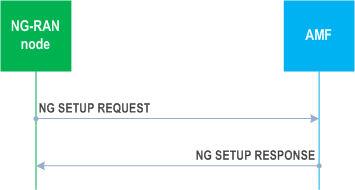
The NG-RAN node initiates the procedure by sending an NG SETUP REQUEST message including the appropriate data to the AMF. The AMF responds with an NG SETUP RESPONSE message including the appropriate data.
If the Configured TAC Indication IE set to "true" is included for a Tracking Area contained in the Supported TA List IE in the NG SETUP REQUEST message, the AMF may take it into account to optimise NG-C signalling towards this NG-RAN node.
If the UE Retention Information IE set to "ues-retained" is included in the NG SETUP REQUEST message, the AMF may accept the proposal to retain the existing UE related contexts and signalling connections by including the UE Retention Information IE set to "ues-retained" in the NG SETUP RESPONSE message.
If the AMF supports IAB, the AMF shall include the IAB Supported IE in the NG SETUP RESPONSE message. If the IAB Supported IE is included in the NG SETUP RESPONSE message, the NG-RAN node shall, if supported, store this information and use it for further AMF selection for the IAB-MT.
The AMF shall include the Backup AMF Name IE, if available, in the Served GUAMI List IE in the NG SETUP RESPONSE message. The NG-RAN node shall, if supported, consider the AMF as indicated by the Backup AMF Name IE when performing AMF reselection, as specified in TS 23.501.
If the GUAMI Type IE is included in the NG SETUP RESPONSE message, the NG-RAN node shall store the received value and use it for further AMF selection as defined in TS 23.501.
If the RAN Node Name IE is included in the NG SETUP REQUEST message, the AMF may use this IE as a human readable name of the NG-RAN node. If the Extended RAN Node Name IE is included in the NG SETUP REQUEST message, the AMF may use this IE as a human readable name of the NG-RAN node and shall ignore the RAN Node Name IE if also included.
If the AMF Name IE is included in the NG SETUP RESPONSE message, the NG-RAN node may use this IE as a human readable name of the AMF. If the Extended AMF Name IE is included in the NG SETUP RESPONSE message, the NG-RAN node may use this IE as a human readable name of the AMF and shall ignore the AMF Name IE if also included.
If the NB-IoT Default Paging DRX IE is included in the NG SETUP REQUEST message, the AMF shall take it into account for paging.
If the RAT Information IE is included in the NG SETUP REQUEST message, the AMF shall handle this information as specified in TS 23.502.
If the NID IE within the NPN Support IE is included within a Broadcast PLMN Item IE in the NG SETUP REQUEST message, the AMF shall consider that the NG-RAN node supports the indicated S-NSSAI(s) for the corresponding tracking area code for the SNPN identified by the PLMN Identity IE and the NID IE.
If the NID IE within the NPN Support IE is included within a PLMN Support Item IE in the NG SETUP RESPONSE message, the NG-RAN node shall consider that the AMF supports the SNPN identified by the PLMN Identity IE and the NID IE.
If the Onboarding Support IE is also included within the same PLMN Support Item IE, the NG-RAN node shall, if supported, consider that the AMF supports UE onboarding for the identified SNPN, as specified in TS 23.501.
If the TAI NSAG Support List IE is included in the Broadcast PLMN Item IE in the NG SETUP REQUEST message, the AMF shall, if supported, use this information as specified in TS 23.501.
If the AMF supports mobile IAB, the AMF shall include the Mobile IAB Supported IE in the NG SETUP RESPONSE message. If the Mobile IAB Supported IE is included in the NG SETUP RESPONSE message, the NG-RAN node shall, if supported, store this information and further use it for AMF selection for the mobile IAB-MT.
8.7.1.3 Unsuccessful Operation p. 96
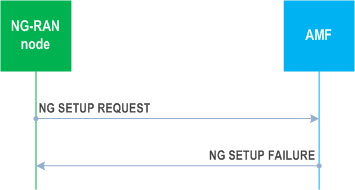
If the AMF cannot accept the setup, it should respond with an NG SETUP FAILURE message and appropriate cause value.
If the NG SETUP FAILURE message includes the Time to Wait IE, the NG-RAN node shall wait at least for the indicated time before reinitiating the NG Setup procedure towards the same AMF.
8.7.1.4 Abnormal Conditions p. 97
If the AMF does not identify any of the PLMNs/SNPNs indicated in the NG SETUP REQUEST message, it shall reject the NG Setup procedure with an appropriate cause value.
If none of the RATs indicated by the NG-RAN node in the NG SETUP REQUEST message is supported by the AMF, then the AMF shall fail the NG Setup procedure with an appropriate cause value.
8.7.2 RAN Configuration Update p. 97
8.7.2.1 General p. 97
The purpose of the RAN Configuration Update procedure is to update application level configuration data needed for the NG-RAN node and the AMF to interoperate correctly on the NG-C interface. This procedure does not affect existing UE-related contexts, if any. The procedure uses non UE-associated signalling.
8.7.2.2 Successful Operation p. 97
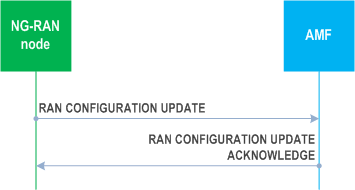
The NG-RAN node initiates the procedure by sending a RAN CONFIGURATION UPDATE message to the AMF including an appropriate set of updated configuration data that it has just taken into operational use. The AMF responds with a RAN CONFIGURATION UPDATE ACKNOWLEDGE message to acknowledge that it successfully updated the configuration data. If an information element is not included in the RAN CONFIGURATION UPDATE message, the AMF shall interpret that the corresponding configuration data is not changed and shall continue to operate the NG-C interface with the existing related configuration data.
If the Supported TA List IE is included in the RAN CONFIGURATION UPDATE message, the AMF shall overwrite the whole list of supported TAs and the corresponding list of supported slices for each TA, and use them for subsequent registration area management of the UE.
If the Configured TAC Indication IE set to "true" is included for a Tracking Area contained in the Supported TA List IE in the RAN CONFIGURATION UPDATE message, the AMF may take it into account to optimise NG-C signalling towards this NG-RAN node.
If the Global RAN Node ID IE is included in the RAN CONFIGURATION UPDATE message, the AMF shall associate the TNLA to the NG-C interface instance using the Global RAN Node ID.
If the RAN CONFIGURATION UPDATE message includes the NG-RAN TNL Association to Remove List IE, the AMF shall, if supported, initiate removal of the TNL association(s) indicated by NG-RAN TNL endpoint(s) and AMF TNL endpoint(s) if the TNL Association Transport Layer Address at AMF IE is present, or the TNL association(s) indicated by NG-RAN TNL endpoint(s) if the TNL Association Transport Layer Address at AMF IE is absent:
- if the received TNL Association Transport Layer Address IE includes the Port Number IE, the NG-RAN TNL endpoint is identified by the Endpoint IP Address IE and the Port Number IE. Otherwise, the NG-RAN TNL endpoints correspond to all NG-RAN TNL endpoints identified by the Endpoint IP Address IE and any port number(s).
- if the received TNL Association Transport Layer Address at AMF IE includes the Port Number IE, the AMF TNL endpoint is identified by the Endpoint IP Address IE and the Port Number IE. Otherwise, the AMF TNL endpoints correspond to all AMF TNL endpoints identified by the Endpoint IP Address IE and any port number(s).
8.7.2.3 Unsuccessful Operation p. 98
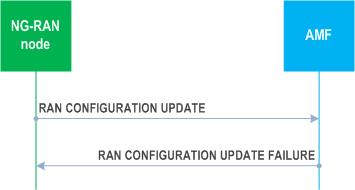
If the AMF cannot accept the update, it shall respond with a RAN CONFIGURATION UPDATE FAILURE message and appropriate cause value.
If the Time to Wait IE is included in the RAN CONFIGURATION UPDATE FAILURE message, the NG-RAN node shall wait at least for the indicated time before reinitiating the RAN Configuration Update procedure towards the same AMF.
8.7.2.4 Abnormal Conditions p. 98
If the NG-RAN node, after initiating the RAN Configuration Update procedure, receives neither a RAN CONFIGURATION UPDATE ACKOWLEDGE nor a RAN CONFIGURATION UPDATE FAILURE message, the NG-RAN node may reinitiate a further RAN Configuration Update procedure towards the same AMF, provided that the content of the new RAN CONFIGURATION UPDATE message is identical to the content of the previously unacknowledged RAN CONFIGURATION UPDATE message.
8.7.3 AMF Configuration Update p. 99
8.7.3.1 General p. 99
The purpose of the AMF Configuration Update procedure is to update application level configuration data needed for the NG-RAN node and AMF to interoperate correctly on the NG-C interface. This procedure does not affect existing UE-related contexts, if any. The procedure uses non UE-associated signalling.
8.7.3.2 Successful Operation p. 99
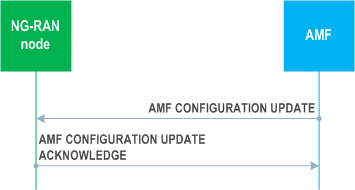
The AMF initiates the procedure by sending an AMF CONFIGURATION UPDATE message including the appropriate updated configuration data to the NG-RAN node. The NG-RAN node responds with an AMF CONFIGURATION UPDATE ACKNOWLEDGE message to acknowledge that it successfully updated the configuration data. Unless stated otherwise, if an information element is not included in the AMF CONFIGURATION UPDATE message, the NG-RAN node shall interpret that the corresponding configuration data is not changed and shall continue to operate the NG-C interface with the existing related configuration data.
If the PLMN Support List IE is included in the AMF CONFIGURATION UPDATE message, the NG-RAN node shall overwrite the whole list of supported PLMN/SNPN Identities and the corresponding list of AMF slices and, if present, other associated information for each PLMN/SNPN Identity and use the received values for further network slice selection and AMF selection.
If the AMF TNL Association to Add List IE is included in the AMF CONFIGURATION UPDATE message, the NG-RAN node shall, if supported, use it to establish the TNL association(s) with the AMF. If the AMF TNL Association to Add List IE is included in the AMF CONFIGURATION UPDATE message, and if the AMF TNL Association Address IE does not include the Port Number IE, the NG-RAN node shall assume that port number value 38412 is used for the endpoint. The NG-RAN node shall report to the AMF, in the AMF CONFIGURATION UPDATE ACKNOWLEDGE message, the successful establishment of the TNL association(s) with the AMF as follows:
- A list of successfully established TNL associations shall be included in the AMF TNL Association Setup List IE;
- A list of TNL associations that failed to be established shall be included in the AMF TNL Association Failed to Setup List IE.
- if the received AMF TNL Association Address IE includes the Port Number IE, the AMF TNL endpoint is identified by the Endpoint IP Address IE and the Port Number IE. Otherwise, the AMF TNL endpoints correspond to all AMF TNL endpoints identified by the Endpoint IP Address IE and any port number(s).
- if the received TNL Association Transport Layer Address NG-RAN IE includes the Port Number IE, the NG-RAN node TNL endpoint is identified by the Endpoint IP Address IE and the Port Number IE. Otherwise, the NG-RAN node TNL endpoints correspond to all NG-RAN node TNL endpoints identified by the Endpoint IP Address IE and any port number(s).
- if the received AMF TNL Association Address IE includes the Port Number IE, the AMF TNL endpoint is identified by the Endpoint IP Address IE and the Port Number IE. Otherwise, the AMF TNL endpoints correspond to all AMF TNL endpoints identified by the Endpoint IP Address IE and any port number(s).
8.7.3.3 Unsuccessful Operation p. 100
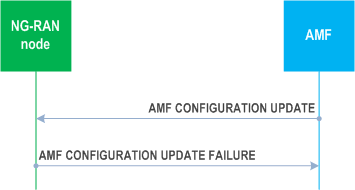
If the NG-RAN node cannot accept the update, it shall respond with an AMF CONFIGURATION UPDATE FAILURE message and appropriate cause value.
If the Time to Wait IE is included in the AMF CONFIGURATION UPDATE FAILURE message, the AMF shall wait at least for the indicated time before reinitiating the AMF Configuration Update procedure towards the same NG-RAN node.
8.7.3.4 Abnormal Conditions p. 100
If the AMF receives neither an AMF CONFIGURATION UPDATE ACKOWLEDGE nor an AMF CONFIGURATION UPDATE FAILURE message, the AMF may reinitiate the AMF Configuration Update procedure towards the same NG-RAN node provided that the content of the new AMF CONFIGURATION UPDATE message is identical to the content of the previously unacknowledged AMF CONFIGURATION UPDATE message.
8.7.4 NG Reset p. 101
8.7.4.1 General p. 101
The purpose of the NG Reset procedure is to initialise or re-initialise the RAN, or part of RAN NGAP UE-related contexts, in the event of a failure in the 5GC or vice versa. This procedure does not affect the application level configuration data exchanged during, e.g., the NG Setup procedure. The procedure uses non-UE associated signalling.
8.7.4.2 Successful Operation p. 101
8.7.4.2.1 NG Reset initiated by the AMF p. 101
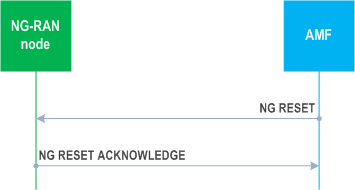
In the event of a failure at the AMF which has resulted in the loss of some or all transaction reference information, an NG RESET message shall be sent to the NG-RAN node.
At reception of the NG RESET message the NG-RAN node shall release all allocated resources on NG and Uu related to the UE association(s) indicated explicitly or implicitly in the NG RESET message and remove the indicated UE contexts including NGAP ID.
After the NG-RAN node has released all assigned NG resources and the UE NGAP IDs for all indicated UE associations which can be used for new UE-associated logical NG-connections over the NG interface, the NG-RAN node shall respond with the NG RESET ACKNOWLEDGE message. The NG-RAN node does not need to wait for the release of radio resources to be completed before returning the NG RESET ACKNOWLEDGE message.
If the NG RESET message contains the UE-associated Logical NG-connection List IE, then:
- The NG-RAN node shall use the AMF UE NGAP ID IE and/or the RAN UE NGAP ID IE to explicitly identify the UE association(s) to be reset.
- The NG-RAN node shall include in the NG RESET ACKNOWLEDGE message, for each UE association to be reset, the UE-associated Logical NG-connection Item IE in the UE-associated Logical NG-connection List IE. The UE-associated Logical NG-connection Item IEs shall be in the same order as received in the NG RESET message and shall include also unknown UE-associated logical NG-connections. Empty UE-associated Logical NG-connection Item IEs, received in the NG RESET message, may be omitted in the NG RESET ACKNOWLEDGE message.
- If the AMF UE NGAP ID IE is included in the UE-associated Logical NG-connection Item IE for a UE association, the NG-RAN node shall include the AMF UE NGAP ID IE in the corresponding UE-associated Logical NG-connection Item IE in the NG RESET ACKNOWLEDGE message.
- If the RAN UE NGAP ID IE is included in the UE-associated Logical NG-connection Item IE for a UE association, the NG-RAN node shall include the RAN UE NGAP ID IE in the corresponding UE-associated Logical NG-connection Item IE in the NG RESET ACKNOWLEDGE message.
If the NG RESET message is received, any other ongoing procedure (except for another NG Reset procedure) on the same NG interface related to a UE association, indicated explicitly or implicitly in the NG RESET message, shall be aborted.
8.7.4.2.2 NG Reset initiated by the NG-RAN node p. 102
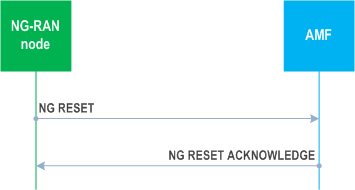
In the event of a failure at the NG-RAN node which has resulted in the loss of some or all transaction reference information, an NG RESET message shall be sent to the AMF.
At reception of the NG RESET message the AMF shall release all allocated resources on NG related to the UE association(s) indicated explicitly or implicitly in the NG RESET message and remove the NGAP ID for the indicated UE associations.
After the AMF has released all assigned NG resources and the UE NGAP IDs for all indicated UE associations which can be used for new UE-associated logical NG-connections over the NG interface, the AMF shall respond with the NG RESET ACKNOWLEDGE message.
If the NG RESET message contains the UE-associated Logical NG-connection List IE, then:
- The AMF shall use the AMF UE NGAP ID IE and/or the RAN UE NGAP ID IE to explicitly identify the UE association(s) to be reset.
- The AMF shall include in the NG RESET ACKNOWLEDGE message, for each UE association to be reset, the UE-associated Logical NG-connection Item IE in the UE-associated Logical NG-connection List IE. The UE-associated Logical NG-connection Item IEs shall be in the same order as received in the NG RESET message and shall include also unknown UE-associated logical NG-connections. Empty UE-associated Logical NG-connection Item IEs, received in the NG RESET message, may be omitted in the NG RESET ACKNOWLEDGE message.
- If the AMF UE NGAP ID IE is included in the UE-associated Logical NG-connection Item IE for a UE association, the AMF shall include the AMF UE NGAP ID IE in the corresponding UE-associated Logical NG-connection Item IE in the NG RESET ACKNOWLEDGE message.
- If the RAN UE NGAP ID IE is included in a UE-associated Logical NG-connection Item IE for a UE association, the AMF shall include the RAN UE NGAP ID IE in the corresponding UE-associated Logical NG-connection Item IE in the NG RESET ACKNOWLEDGE message.
If the NG RESET message is received, any other ongoing procedure (except for another NG Reset procedure) on the same NG interface related to a UE association, indicated explicitly or implicitly in the NG RESET message, shall be aborted.
8.7.4.3 Unsuccessful Operation p. 102
Not applicable.
8.7.4.4 Abnormal Conditions p. 102
8.7.4.4.1 Abnormal Condition at the 5GC p. 102
If the NG RESET message includes the UE-associated Logical NG-connection List IE, but neither the AMF UE NGAP ID IE nor the RAN UE NGAP ID IE is present for a UE-associated Logical NG-connection Item IE, then the AMF shall ignore the UE-associated Logical NG-connection Item IE. The AMF may return the empty UE-associated Logical NG-connection Item IE in the UE-associated Logical NG-connection List IE in the NG RESET ACKNOWLEDGE message.
8.7.4.4.2 Abnormal Condition at the NG-RAN p. 103
If the NG RESET message includes the UE-associated Logical NG-connection List IE, but neither the AMF UE NGAP ID IE nor the RAN UE NGAP ID IE is present for a UE-associated Logical NG-connection Item IE, then the NG-RAN node shall ignore the UE-associated Logical NG-connection Item IE. The NG-RAN node may return the empty UE-associated Logical NG-connection Item IE in the UE-associated Logical NG-connection List IE in the NG RESET ACKNOWLEDGE message.
8.7.4.4.3 Crossing of NG RESET Messages p. 103
If an NG Reset procedure is ongoing in the NG-RAN node and the NG-RAN node receives an NG RESET message from the peer entity on the same NG interface related to one or several UE associations previously requested to be reset, indicated explicitly or implicitly in the received NG RESET message, the NG-RAN node shall respond with the NG RESET ACKNOWLEDGE message as described in clause 8.7.4.2.1.
If an NG Reset procedure is ongoing in the AMF and the AMF receives an NG RESET message from the peer entity on the same NG interface related to one or several UE associations previously requested to be reset, indicated explicitly or implicitly in the received NG RESET message, the AMF shall respond with the NG RESET ACKNOWLEDGE message as described in clause 8.7.4.2.2.
8.7.5 Error Indication p. 103
8.7.5.1 General p. 103
The Error Indication procedure is initiated by a node in order to report detected errors in one incoming message, provided they cannot be reported by an appropriate failure message.
If the error situation arises due to reception of a message utilising UE-associated signalling, then the Error Indication procedure uses UE-associated signalling. Otherwise the procedure uses non-UE associated signalling.
8.7.5.2 Successful Operation p. 103
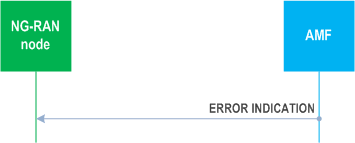
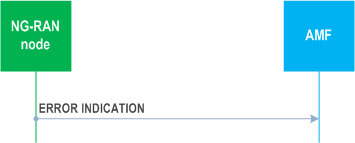
When the conditions defined in clause 10 are fulfilled, the Error Indication procedure is initiated by an ERROR INDICATION message sent from the receiving node.
The ERROR INDICATION message shall contain at least either the Cause IE or the Criticality Diagnostics IE. In case the Error Indication procedure is triggered by utilising UE-associated signalling the AMF UE NGAP ID IE and the RAN UE NGAP ID IE shall be included in the ERROR INDICATION message. If one or both of the AMF UE NGAP ID IE and the RAN UE NGAP ID IE are not correct, the cause shall be set to an appropriate value, e.g., "Unknown local UE NGAP ID" or "Inconsistent remote UE NGAP ID".
8.7.5.3 Abnormal Conditions p. 104
Void.
8.7.6 AMF Status Indication p. 104
8.7.6.1 General p. 104
The purpose of the AMF Status Indication procedure is to support AMF management functions. The procedure uses non UE-associated signalling.
8.7.6.2 Successful Operation p. 104
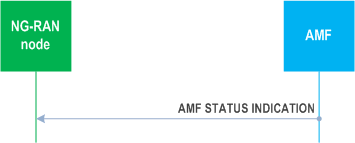
The AMF initiates the procedure by sending an AMF STATUS INDICATION message to the NG-RAN node.
Upon receipt of the AMF STATUS INDICATION message, the NG-RAN node shall consider the indicated GUAMI(s) will be unavailable and perform AMF reselection as defined in TS 23.501.
The NG-RAN node shall, if supported, act accordingly as specified in TS 23.501, based on the presence or absence of the Timer Approach for GUAMI Removal IE.
If the Backup AMF Name IE is included in the AMF STATUS INDICATION message, the NG-RAN node shall, if supported, perform AMF reselection considering the AMF as indicated by the Backup AMF Name IE as specified in TS 23.501.
8.7.6.3 Abnormal Conditions p. 105
Void.
8.7.7 Overload Start p. 105
8.7.7.1 General p. 105
The purpose of the Overload Start procedure is to inform an NG-RAN node to reduce the signalling load towards the concerned AMF. The procedure uses non-UE associated signalling.
8.7.7.2 Successful Operation p. 105
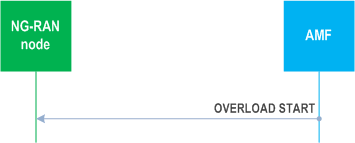
The NG-RAN node receiving the OVERLOAD START message shall assume the AMF from which it receives the message as being in an overloaded state.
If the Overload Action IE is included the AMF Overload Response IE within the OVERLOAD START message, the NG-RAN node shall use it to identify the related signalling traffic. When the Overload Action IE is set to
- "reject RRC connection establishments for non-emergency mobile originated data transfer" (i.e., reject traffic corresponding to RRC cause "mo-data", "mo-SMS", "mo-VideoCall" and "mo-VoiceCall" in TS 38.331 or "mo-data" and "mo-VoiceCall" in TS 36.331), or
- "reject RRC connection establishments for signalling" (i.e., reject traffic corresponding to RRC cause "mo-data", "mo-SMS", "mo-signalling", "mo-VideoCall" and "mo-VoiceCall" in TS 38.331 or "mo-data", "mo-signalling" and "mo-VoiceCall" in TS 36.331), or
- "only permit RRC connection establishments for emergency sessions and mobile terminated services" (i.e., only permit traffic corresponding to RRC cause "emergency" and "mt-Access" in TS 38.331 or in TS 36.331), or
- "only permit RRC connection establishments for high priority sessions and mobile terminated services" (i.e., only permit traffic corresponding to RRC cause "highPriorityAccess", "mps-PriorityAccess", "mcs-PriorityAccess" and "mt-Access" in TS 38.331 or "highPriorityAccess", "mo-ExceptionData" and "mt-Access" in TS 36.331),
- if the AMF Traffic Load Reduction Indication IE is included in the OVERLOAD START message, reduce the signalling traffic by the indicated percentage,
- otherwise ensure that only the signalling traffic not indicated as to be rejected is sent to the AMF.
- if the Slice Traffic Load Reduction Indication IE is present, reduce the signalling traffic by the indicated percentage for the UE(s) whose requested NSSAI only include S-NSSAI(s) contained in the Overload Start NSSAI List IE, and the signalling traffic indicated as to be reduced by the Overload Action IE in the Slice Overload Response IE if the IE is present,
- otherwise ensure that only the signalling traffic from UE(s) whose requested NSSAI includes S-NSSAI(s) other than the ones contained in the Overload Start NSSAI List IE, or the signalling traffic not indicated as to be reduced by the Overload Action IE in the Slice Overload Response IE for the UE(s) if the requested NSSAI matched, is sent to the AMF.
8.7.7.3 Abnormal Conditions p. 106
Void.
8.7.8 Overload Stop p. 106
8.7.8.1 General p. 106
The purpose of the Overload Stop procedure is to signal to an NG-RAN node the AMF is connected to that the overload situation at the AMF has ended and normal operation shall resume. The procedure uses non-UE associated signalling.
8.7.8.2 Successful Operation p. 106
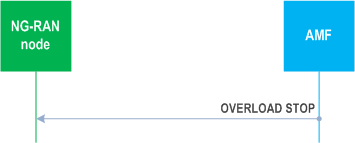
The NG-RAN node receiving the OVERLOAD STOP message shall assume that the overload situation at the AMF from which it receives the message has ended and shall resume normal operation for the applicable traffic towards this AMF.
8.7.8.3 Abnormal Conditions p. 106
Void.